1. Main points
Nominal gross value added (GVA) per hour worked levels in 2015 ranged from 32% above the UK average in London to 19% below the UK average in Wales and Northern Ireland; the regions in the North and Midlands of England ranged between 10% to 15% below the UK average.
Alongside London, the only city regions with labour productivity above the UK average in 2015 were Aberdeen and Bristol with levels 15% and 2% above the UK average; South Yorkshire (Sheffield) had the lowest labour productivity of the city regions at 17% below the UK average.
All 21 sub-regions1 in London had productivity above the UK average in 2015 with the highest in Tower Hamlets (79% above the UK average); out of 147 sub-regions in Great Britain that are not in London, 26 had labour productivity above the UK average with 19 of these areas in the South of England, 3 in the North and Midlands of England and 4 in Scotland.
There were 37 sub-regions with labour productivity 15% or more below the UK average in 2015 (2 in the South of England, 5 in Scotland, 7 in Wales, 9 in the Midlands and 14 in the North of England); the lowest productivity levels were found in Powys in Wales and Blackpool in North West England.
Notes for main points
- These sub-regions are based on the NUTS3 (Nomenclature of Territorial Units for Statistics) geography. For more information about the current classification, see the Geographies note in the Methodology section.
2. Introduction
This article provides statistics for both of our main measures of labour productivity, gross value added (GVA) per hour worked and GVA per filled job. They are provided for the NUTS1, NUTS2 and NUTS3 (Nomenclature of Territorial Units for Statistics) subregions of the UK, and for selected UK city regions.
Productivity is a widely used measure of economic performance capturing how much output is produced by a set of given inputs such as capital or labour. The data in this report measure labour productivity which is defined as the ratio of output (such as gross value added) divided by the labour input used to create it. It is one of the most widely used measures of economic performance of a nation or an area. A higher level of productivity means that a higher level of output is being produced per unit of labour input.
Productivity matters because increasing productivity is critical to increasing economic growth in the long run. This follows from the fact that economic output can only be increased by either increasing the amount of inputs or by raising productivity. Furthermore, changes in labour productivity are also related to changes in real wages. Increasing productivity is, therefore, an important aim for both national and local economies. As shown in the "Results" sections in this report, there is currently a wide spatial divergence in levels of productivity between different subregions.
Note that the productivity analysis in this article uses nominal GVA which does not by definition take account of any regional or local price differences or different factor prices faced by the firms. It should also be noted that labour productivity can be affected by the relative intensity of use of other inputs such as capital or technology. Labour input can be measured as the number of jobs, workers or hours worked. The preferred measure of labour productivity is GVA per hour worked as it takes into account different working patterns.
The article updates previous sub-regional productivity releases. It explores labour productivity as GVA per hour worked using aggregated data at various geographical levels. Productivity estimates for most of these geographies are also available as GVA per filled job in the accompanying datasets. These regional productivity measures include all sectors of economic activity. Headline results are summarised in sections 3 to 5. Greater detail is provided in sections "interpreting the data" and "methodology".
In addition, users may be interested to note that some limited data for an alternative measure of productivity, one that excludes rental income from total GVA, has also been provided in section 6. Further details of this measure, and a discussion of the reasons for its inclusion, are included in the relevant results and methodology sections.A separate article titled Regional firm level productivity analysis for the non-financial business economy has also been published. That article aims to complement the headline subregional productivity measures included in this article by providing some insight on the underlying firm level productivity distributions in different areas.
Nôl i'r tabl cynnwys3. Results for NUTS1 regions and countries
Figure 1 shows labour productivity estimates for each of the NUTS1 (Nomenclature of Territorial Units for Statistics) regions and countries of the UK. The results are presented in terms of gross value added (GVA) per hour worked and GVA per job filled. Both productivity measures are expressed relative to the UK average for each year (a UK=100 index) – see the methodology section for more information on how to interpret data in index form.
The differences between the results for the GVA per hour worked and GVA per job filled estimates reflect differences in average hours worked across the regions, with average hours per job higher than the UK average in London and Northern Ireland and lower than the UK average in the South West of England.
Figure 1: Labour productivity by NUTS 1 region or country, 2015
Source: Office for National Statistics
Download this chart Figure 1: Labour productivity by NUTS 1 region or country, 2015
Image .csv .xlsGVA per hour worked was highest in 2015 in London at 32% above the UK average. The only other region with productivity above the UK average was the South East of England with productivity 9% above the UK average. In Scotland, productivity in 2015 was 2% below the UK average whilst in Wales and Northern Ireland productivity was 19% below the UK average. The regions of the north and midlands of England (North East, North West, Yorkshire and the Humber, East Midlands and West Midlands) had productivity levels between 10% to 15% below the UK average.
Figure 2 shows GVA per hour worked from 1997 to 2015 for the 5 UK regions and countries with the highest levels of productivity. It shows that changes in relative rankings between regions are rare indicating the long-standing nature of many of these regional differences. However, there have been some changes over time with both London and Scotland seeing improvements in relative productivity levels since 2003.
While productivity levels have remained relatively constant there have, however, been quite big differences in the rates of economic growth over this period. These have generally not been caused by major shifts in relative productivity performance. Instead they have largely reflected the differing growth in labour input over the period. For example, from 1997 to 2015, productivity hours in London increased by 34%, which was more than double the growth rate in any other NUTS1 region or country. As such, London’s relatively strong growth in GVA (it has seen its share of UK GVA increase from 18.7% to 22.7% from 1997 to 2015) has been due to a continued productivity advantage per hour worked combined with a significantly higher increase in total hours worked compared with the rest of the UK.
Figure 2: NUTS 1 regions and countries with highest GVA per hour worked, 1997 to 2015
Source: Office for National Statistics
Download this chart Figure 2: NUTS 1 regions and countries with highest GVA per hour worked, 1997 to 2015
Image .csv .xls4. Results by NUTS2 subregions and city regions
This section presents the main results of the labour productivity estimates for the 40 NUTS2 (Nomenclature of Territorial Units for Statistics) subregions of the UK, focusing on estimates of nominal GVA per hour worked. Productivity calculations for selected UK city regions based on the same indicator are also provided. Both the GVA data and the hours worked data are on a workplace basis providing a workplace measure of productivity for each area. All data have been smoothed based on a weighted average of up to 5 years’ data (see methodology section for more information).
Figure 3: GVA per hour worked - highest ranking UK NUTS2 subregions, 2015
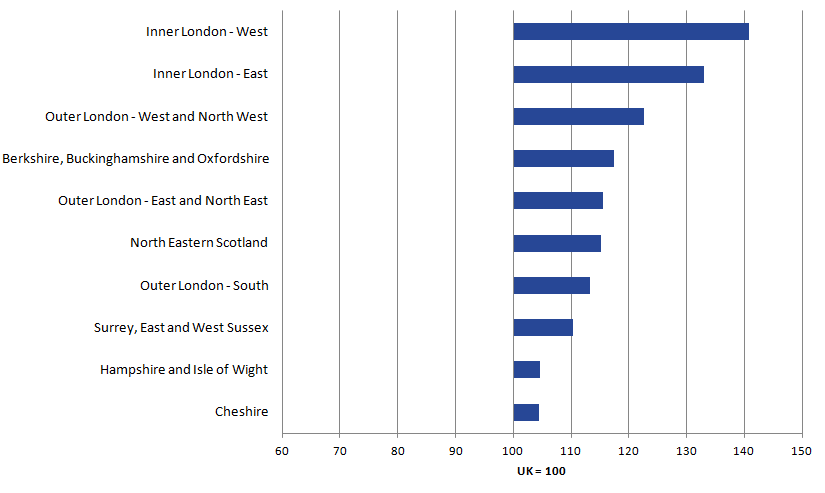
Source: Office for National Statistics
Download this image Figure 3: GVA per hour worked - highest ranking UK NUTS2 subregions, 2015
.png (15.2 kB) .xls (29.7 kB)All 5 NUTS2 subregions in the Greater London area ranked among the 10 most productive in the UK in terms of GVA per hour worked. They all registered productivity levels above the UK average. Inner London West showed the highest productivity level, with a GVA per hour worked around 41% higher than the UK average. This was followed by Inner London East (33% above average). Berkshire, Buckinghamshire and Oxfordshire is the highest-ranked NUTS2 area outside Greater London (17% above average). Overall, 11 out of the 40 NUTS2 subregions had productivity levels above the UK average.
Figure 4: GVA per hour worked - lowest ranking UK NUTS2 subregions, 2015

Source: Office for National Statistics
Download this image Figure 4: GVA per hour worked - lowest ranking UK NUTS2 subregions, 2015
.png (12.8 kB) .xls (21.5 kB)Figure 4 shows the NUTS2 regions with the lowest labour productivity levels. Each had productivity at least 13% below the UK average. Most of the places with the lowest productivity levels are relatively rural areas of the country, for example, Cornwall and Isles of Scilly and West Wales and The Valleys.
Figure 5 provides labour productivity for selected UK city regions in 2015. City regions are of particular policy interest at the present time. In England, a number of city region areas have been granted increased devolution powers over the past 2 years, while in Scotland and Wales city deals have been agreed between some city regions and the UK government. Figure 5 provides data for 13 of the largest city region areas in the UK. Information on the boundaries used for the city regions can be found in the Geographies note in the Methodology section.
Figure 5: GVA per hour worked - City Regions, 2015
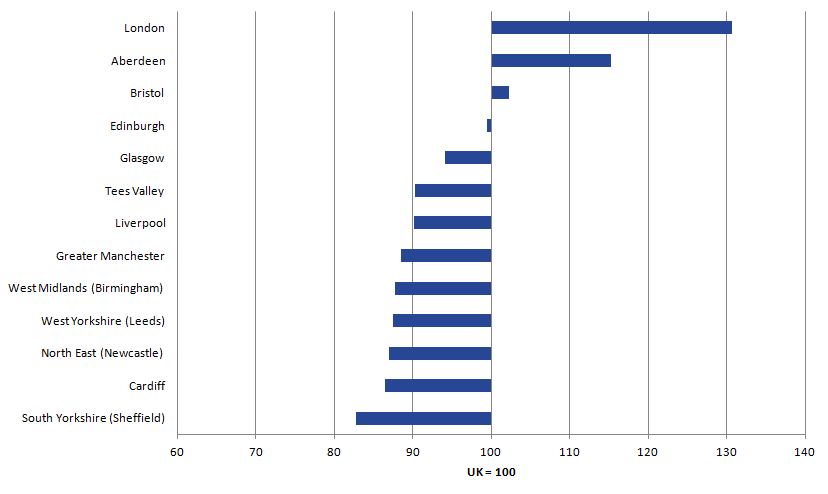
Source: Office for National Statistics
Download this image Figure 5: GVA per hour worked - City Regions, 2015
.png (13.8 kB) .xls (21.5 kB)As with the earlier regional data, London has the highest labour productivity. It is followed by the Aberdeen city region with productivity 15% above the UK average. Bristol and Edinburgh city regions both had productivity close to the UK average while Glasgow was 6% below the UK average. The city regions in the north and midlands of England had productivity between 10% and 17% below the UK average. South Yorkshire (Sheffield city region) had the lowest productivity. In Wales, Cardiff city region had productivity 14% below the UK average.
Examining the city region data over a 10-year period since 2005, only London and Bristol of the English city regions have seen productivity increase more quickly than the UK overall. The Scottish cities of Aberdeen, Glasgow and Edinburgh have also seen improvements over this period in relative productivity performance.
Nôl i'r tabl cynnwys5. Results for England, Scotland, Wales and Northern Ireland by NUTS3 subregions
This section presents the results of the labour productivity estimates for England, Scotland, Wales and Northern Ireland by NUTS3 (Nomenclature of Territorial Units for Statistics) subregions in 2015. Both the gross value added (GVA) data and the hours worked data are on a workplace basis providing a workplace measure of productivity for each area. Results for England are presented separately for London, the rest of the South of England, the Midlands and the North.
Except for Northern Ireland, the labour productivity estimates focus on nominal GVA per hour worked as the preferred subregional labour productivity measure. For Northern Ireland, the productivity estimates are based on nominal GVA per job filled1. In all cases, the data have been smoothed based on a weighted moving average of up to 5 years’ data (see methodology section for more information).
Results for London
Figure 6 shows the NUTS3 subregions in the Greater London area with the highest and lowest productivity levels.
Figure 6: GVA per hour worked - London - highest and lowest ranking NUTS3 subregions, 2015

Source: Office for National Statistics
Download this image Figure 6: GVA per hour worked - London - highest and lowest ranking NUTS3 subregions, 2015
.png (16.7 kB) .xls (21.5 kB)All the 21 NUTS3 subregions in the Greater London area displayed productivity levels above the UK average in 2015. The highest level was in Tower Hamlets with a productivity level 79% above the UK average. This was followed by Wandsworth, Kensington and Chelsea and Hammersmith and Fulham, and Camden and City of London, with productivity levels between 48% and 46% above average. The lowest levels of labour productivity in London were in Lewisham and Southwark at 4% above the UK average.
The very high productivity levels in the Greater London region lead to a skewed distribution of productivity levels across the UK such that relatively few subregions have productivity levels above the UK (mean) average. In 2015, just 47 out of 168 NUTS3 subregions across England, Scotland and Wales had a GVA per hour worked above the UK average, of which 21 were in London.
Given the skewed nature of the distribution, it is worth considering how the productivity level of the mid-ranking (median) subregions compares with the UK average. In 2015, the subregion occupying the middle position in the NUTS3 productivity ranking had a GVA per hour worked of around 92% of the UK average; that is, a productivity level that was 8% below the UK average.
Results for the South of England (excluding London)
Figure 7 shows the highest and lowest levels of productivity in the NUTS3 subregions in the South of England (excluding London), which includes subregions in the South East, South West and East of England regions of England.
Figure 7: GVA per hour worked - South of England (excl. London) - highest and lowest ranking NUTS3 subregions, 2015
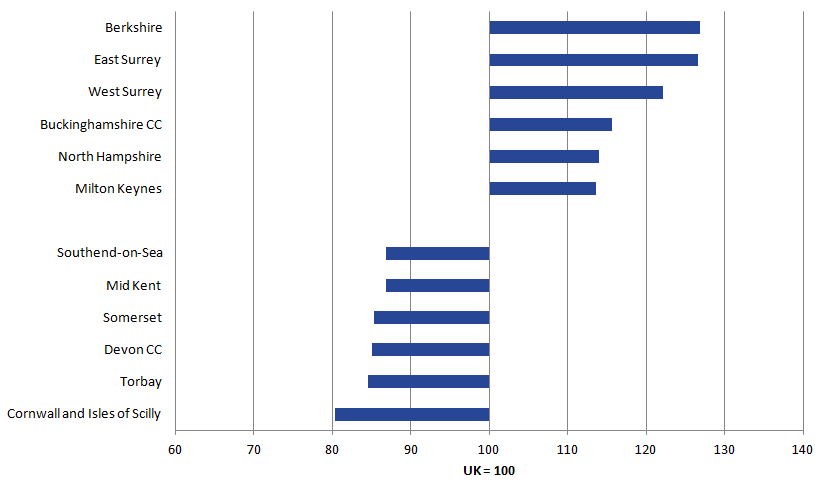
Source: Office for National Statistics
Download this image Figure 7: GVA per hour worked - South of England (excl. London) - highest and lowest ranking NUTS3 subregions, 2015
.png (14.4 kB) .xls (22.0 kB)Productivity levels well above the UK average occurred in the most productive areas of the South of England outside Greater London. Berkshire and East Surrey both displayed productivity levels around 27% above UK average, the highest levels outside of London. Overall, 19 out of 49 NUTS 3 subregions in the South of England had productivity above the UK average. The lowest labour productivity levels in 2015 in the South of England were generally in rural or coastal areas. The lowest was in Cornwall and Isles of Scilly, followed by Torbay and Devon CC. This reflects the regional performance described.
Results for the Midlands
Figure 8 shows the NUTS3 subregions with the highest and lowest productivity in the Midlands, comprising the West Midlands and East Midlands regions.
Figure 8: GVA per hour worked - Midlands - highest and lowest ranking NUTS3 subregions, 2015
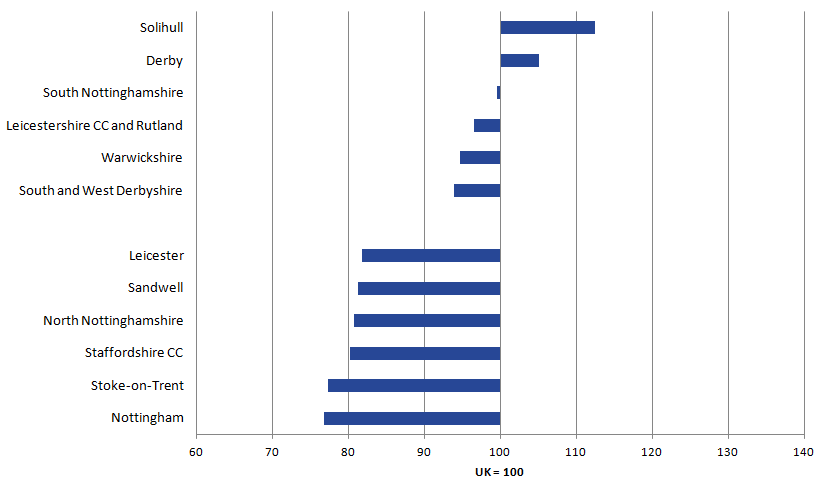
Source: Office for National Statistics
Download this image Figure 8: GVA per hour worked - Midlands - highest and lowest ranking NUTS3 subregions, 2015
.png (14.8 kB) .xls (21.5 kB)In the Midlands, there were 2 NUTS3 subregions with productivity levels above the UK average in 2015. Solihull had the highest productivity level, 12% above the UK average. This was followed by Derby, 5% above the UK average. It should be noted that both Solihull and Derby are home to car or aerospace manufacturing plants and that these are industrial sectors that typically has high labour productivity levels. At the other end of the distribution, productivity levels of over 20% below the UK average were registered in Nottingham and Stoke-on-Trent.
Results for the North of England
Figure 9 shows the NUTS3 subregions with the highest and lowest productivity in the North of England, comprising the North West, North East and Yorkshire and The Humber regions.
Figure 9: GVA per hour worked - North of England - highest and lowest ranking NUTS3 subregions, 2015
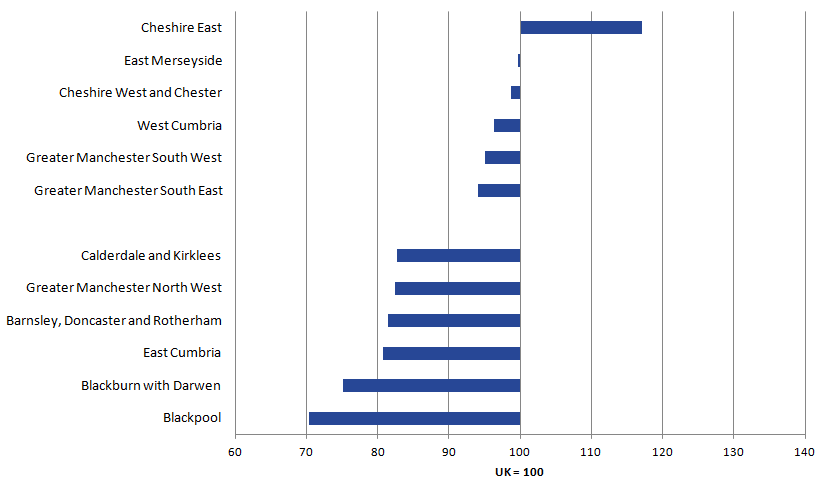
Source: Office for National Statistics
Download this image Figure 9: GVA per hour worked - North of England - highest and lowest ranking NUTS3 subregions, 2015
.png (16.8 kB) .xls (21.5 kB)With the highest labour productivity in the North of England, Cheshire East achieved a productivity level of 17% above the UK average in 2015. This is followed by East Merseyside, with productivity similar to the UK average and Cheshire West and Chester (Note that these NUTS3 areas all include car manufacturing plants). All other best-performing NUTS3 regions presented in the chart had productivity levels below the UK average. The lowest productivity performance was recorded in North West subregions, with productivity levels 25% below the UK average in Blackburn with Darwen and 30% below the UK average in Blackpool, giving Blackpool the worst productivity performance in England.
Results for Scotland
Figure 10 shows the productivity ranking of NUTS3 subregions for Scotland focusing on the subregions with the highest and lowest levels.
Figure 10: GVA per hour worked - Scotland - highest and lowest ranking NUTS3 subregions, 2015

Source: Office for National Statistics
Download this image Figure 10: GVA per hour worked - Scotland - highest and lowest ranking NUTS3 subregions, 2015
.png (18.1 kB) .xls (22.0 kB)In Scotland, Aberdeen City and Aberdeenshire registered the highest productivity level in 2015, 15% above the average for the UK. The City of Edinburgh followed in the ranking, 8% above the UK average. The Shetland Islands had the lowest estimated productivity level, 23% below the average for the UK.
Results for Wales
Figure 11 shows the ranking of productivity levels for all NUTS3 subregions in Wales.
Figure 11: GVA per hour worked - Wales - NUTS3 subregions, 2015
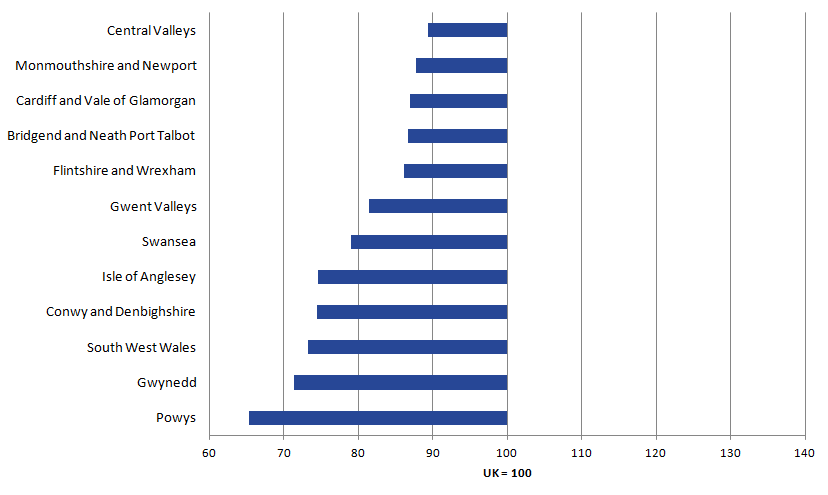
Source: Office for National Statistics
Download this image Figure 11: GVA per hour worked - Wales - NUTS3 subregions, 2015
.png (16.7 kB) .xls (21.5 kB)Productivity levels in all NUTS3 subregions in Wales were below the average for the UK. The NUTS3 subregion with the highest level of labour productivity was Central Valleys, with productivity 11% below the UK average.
Monmouthshire and Newport, Cardiff and Vale of Glamorgan, Bridgend and Neath Port Talbot and Flintshire and Wrexham all displayed levels of productivity around 12% to 14% below the UK average. The lowest performance was the rural subregion of Powys, with a level 35% below the UK average, the lowest level in the UK.
Results for Northern Ireland
Figure 12 shows the ranking in productivity levels for all NUTS3 subregions in Northern Ireland. Unlike all other productivity measures in this article which are based on nominal GVA per hour worked, data for Northern Ireland are available only as GVA per filled job.
Figure 12: GVA per filled Job - Northern Ireland - NUTS3 subregions, 2015
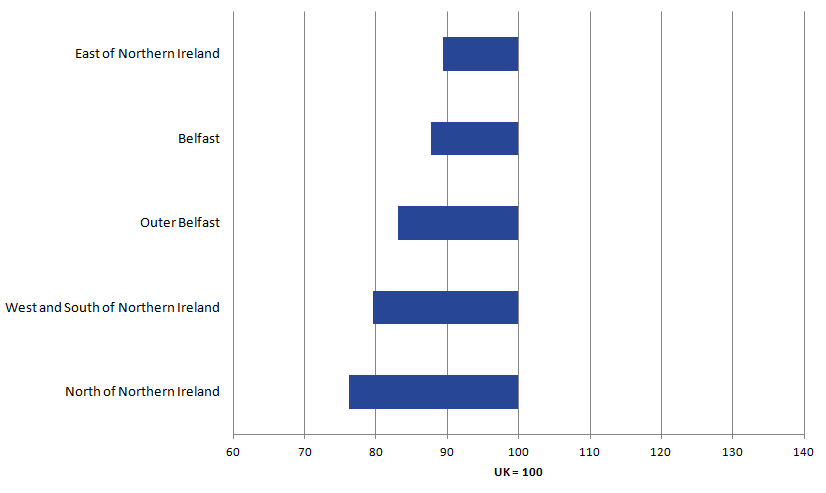
Source: Office for National Statistics
Download this image Figure 12: GVA per filled Job - Northern Ireland - NUTS3 subregions, 2015
.png (9.1 kB) .xls (29.7 kB)Productivity measured as nominal GVA per filled job shows that all NUTS3 subregions in Northern Ireland ranked below the UK average in 2015. The strongest performance was recorded in East of Northern Ireland, with productivity levels 11% below the UK average. The North of Northern Ireland was the weakest performing sub-region, with productivity 24% below UK average.
Notes for Results for England, Scotland, Wales and Northern Ireland by NUTS3 subregions
- GVA per hour NUTS3 data for Northern Ireland are not available. Data are available for GVA per job filled.
6. Alternative results excluding rental income
All productivity calculations presented above adopt total gross value added (GVA) as the measure of output. However, it can be argued that not all GVA components are equally relevant when assessing labour productivity, as some elements of GVA are not directly related to the input of labour. In particular, rental incomes, which for example include imputed rental values capturing the value of housing services accruing to owner-occupiers, can be excluded from total GVA to obtain a measure of output more closely related to the measurable labour input.
This section briefly assesses the impact on the labour productivity data from excluding rental income from the calculations. Figure 13 shows the NUTS3 subregions for which exclusion of rental income has the strongest impact in either increasing or decreasing labour productivity estimates compared with the total GVA per hour worked data presented in the earlier sections of this article.
Figure 13: GVA per hour worked - Exclusion of rental income - UK NUTS3 subregions with largest and smallest Index change, 2015
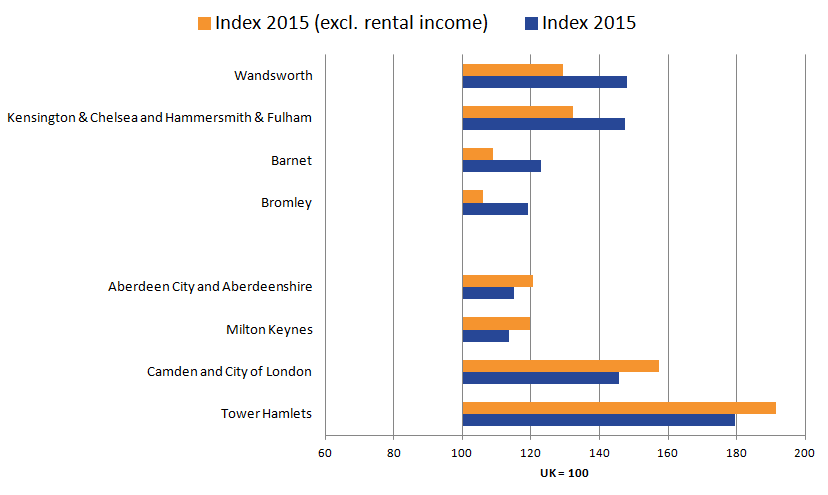
Source: Office for National Statistics
Download this image Figure 13: GVA per hour worked - Exclusion of rental income - UK NUTS3 subregions with largest and smallest Index change, 2015
.png (14.4 kB) .xls (32.8 kB)The impact of removing rental incomes is largest on some of the London sub-regions. Wandsworth and Kensington and Chelsea and Hammersmith and Fulham are the subregions that experience the largest decrease in productivity index with the removal of rental incomes, whereas Tower Hamlets and Camden and the City of London have the largest increase in productivity index from removing rental incomes.
Table 1 shows the impact of removing rental incomes for the latest 2015 data for NUTS 1 (Nomenclature of Territorial Units for Statistics) regions and countries. It shows that London’s productivity index is slightly lower if rental incomes are excluded. The biggest relative increases in the productivity index from removing rental incomes are found in Northern Ireland and Scotland. The South West, South East and East of England all have a lower productivity index with rental incomes excluded.
Table 1: Labour Productivity (GVA per hour) including and excluding rental incomes, 2015 (UK=100)
| GVA per Hour | GVA per Hour (excluding Rental Incomes) | |
| North East | 87.5 | 88.6 |
| North West | 90.1 | 91.7 |
| Yorkshire and The Humber | 86.1 | 86.9 |
| East Midlands | 86.9 | 88 |
| West Midlands | 85.3 | 86.1 |
| East of England | 99.3 | 98 |
| London | 131.5 | 130.4 |
| South East | 109.2 | 107.8 |
| South West | 92.9 | 90.7 |
| Wales | 80.6 | 80.1 |
| Scotland | 98.4 | 100.9 |
| Northern Ireland | 80.9 | 84.9 |
| Source: Office for National Statistics | ||
Download this table Table 1: Labour Productivity (GVA per hour) including and excluding rental incomes, 2015 (UK=100)
.xls (26.6 kB)Looking at growth over the decade from 2005, removing rental incomes from the calculation removes much of the higher increase in productivity in London relative to other regions and countries noted earlier in section 3. With rental incomes removed, growth in the productivity index in London only increases from 129.9 to 130.4 over the decade to 2015 compared with the increase from 127.8 to 131.5 when rental incomes are included.
Elsewhere, removing rental incomes leads to slightly better relative productivity growth in a number of other countries and regions, with Northern Ireland and East Midlands displaying the biggest positive impact relative to the case where rental income is included. In Northern Ireland, the productivity index increases between 2005 and 2015 from 82.4 to 84.9 with rental income excluded (compared with 80.0 – 80.9 with rental incomes included) while in East Midlands the productivity index increases over the same period from 87.4 to 88.0 with rental incomes excluded as opposed to a decline from 87.8 to 86.9 with rental incomes included.
Table 2 shows the impact of removing rental incomes for the latest 2015 data for City regions. With the exception of London1, every city region has a higher productivity index with rental incomes excluded compared with the headline data including rental incomes.
Table 2: Labour Productivity (GVA per hour) excluding Rental Incomes for City Regions, 2015 (UK=100)
| GVA per Hour | GVA per Hour (excluding Rental Incomes) | |
| London | 130.7 | 130 |
| South Yorkshire (Sheffield) | 82.8 | 83.8 |
| West Yorkshire (Leeds) | 87.5 | 88.6 |
| West Midlands (Birmingham) | 87.7 | 89.5 |
| Greater Manchester | 88.5 | 90.1 |
| Liverpool | 90.2 | 91.9 |
| Bristol | 102.3 | 103.1 |
| North East (Newcastle) | 86.9 | 87.9 |
| Glasgow | 94.1 | 97.4 |
| Edinburgh | 99.4 | 101.5 |
| Cardiff | 86.5 | 86.9 |
| Tees Valley | 90.3 | 91.6 |
| Aberdeen | 115.2 | 120.5 |
| Source: Office for National Statistics | ||
Download this table Table 2: Labour Productivity (GVA per hour) excluding Rental Incomes for City Regions, 2015 (UK=100)
.xls (26.6 kB)If you wish to investigate this issue of rental incomes in more detail, data are available in the dataset accompanying this article for productivity calculated excluding rental incomes for NUTS 1, NUTS 2 and NUTS 3 geographies.
Notes for Alternative results excluding rental income
- Note that the data for London differs slightly between tables 1 and 2 because NUTS1 data is calculated using unsmoothed data and city regions data is calculated using smoothed data (see methodology section for more details).
7. Interpreting the Data
This section discusses some useful information that may be of help to utilise and interpret the data in this release including the accompanying datasets. In particular, it examines:
- The differences, in terms of analysing economic performance, between the labour productivity data in this release and gross value added (GVA) per head data.
- The differences between the 2 labour productivity measures included in this release, namely GVA per hour worked and GVA per filled job
- Using the data in this release for time series analysis.
You may also find it useful to examine the Methodology section which provides further details on the smoothing process, geographies, data revisions and consistency with other published productivity data.
7.1. Comparison of labour market productivity measures and GVA per head
GVA per head is sometimes used as an indicator of a sub-region’s economic performance and is calculated as the simple ratio of economic activity in a region divided by the number of people living in that region. At first sight, GVA per head appears to be an appropriate indicator of productivity as it compares the output of a region (GVA) with an input (population). However, there are key weaknesses to using it in this way:
- GVA per head is dividing a workplace-based numerator (GVA) by a residence-based denominator (residential population); this means that this measure does not account for people commuting into and out of a region, and significant commuting flows can lead to highly distorted results
- by including all the residential population (including children, pensioners and others not economically active) and not just those who are in employment, the denominator includes residents who are not directly contributing to GVA
Therefore, it is recommended to use a suite of different indicators, including the productivity measures published in this article, when assessing the economic performance of regions and subregions.
For these reasons, GVA per hour worked and GVA per filled job are the most appropriate measure of regional and subregional productivity. These measures only count the input of those who are directly employed in the production process, rather than the whole population. Additionally, they provide a workplace-based labour input denominator to match the workplace-based GVA numerator, thus fully accounting for the impacts of commuting. The differences in the results between subregional labour productivity and GVA per head can be very large. This is particularly the case for subregions that have large commuting flows, such as Inner London. In such cases, use of GVA per head can give an unrealistic picture of the subregions relative economic performance.
7.2. Difference between GVA per Hour Worked and GVA per Filled Job
GVA per hour worked and GVA per filled job can both be used as measures of labour productivity, but these 2 measures are different. GVA per hour worked divides GVA by the total hours worked by the workforce in the subregion; GVA per filled job apportions GVA to the number of jobs in the subregion.
There will be some small differences between the results for the 2 measures. This occurs because the average of hours worked per job varies from subregion to subregion as a result of differences in labour market structure and working patterns. For example, a subregion with high levels of part-time employment will tend to have lower average hours worked per job.
GVA per filled job does not take into consideration regional labour market structures or different working patterns, such as the mix of part-time and full-time workers, and job shares. For this reason, GVA per hour worked is a more comprehensive indicator of labour productivity and the preferred measure at sub-national level. GVA per hour worked data are currently available for the period 2004 to 2015 and GVA per filled job data are available for the period 2002 to 2015 for (Nomenclature of Territorial Units for Statistics) NUTS 2 and 3 geographies. Data is available from 1997 for the NUTS1 regional geography.
7.3. Time series trend analysis
Data presented in this publication covers a period of up to 14 years and, subject to the caveats detailed below, it is possible to look at the variation in the data over a period of time. When comparing areas it is important to note the data is only in nominal terms and differences in local price deflators over time could account for some of the variation.
7.3.1. Choice of smoothed or unsmoothed data
Caution is needed when carrying out a change over time analysis of the subregional productivity data. Particularly for NUTS3 data, there is volatility in the data that arises from the smaller survey samples inherent within estimates for smaller geographic areas. It is for this reason that smoothed subregional productivity data is presented in this article. The smoothed data reduce the volatility by using weighted data from up to 5 years in producing the estimate for each year.
When using this smoothed data for time-series analysis, examining a particular year-on-year change does not really make sense, because each year’s data are already a weighted average of a number of different years. Therefore, to examine a year-on-year change, for example from 2014 to 2015, the only suitable method would be to use the unsmoothed data that are available in the accompanying datasets.
However, because of the volatility of the data, this year-on-year change may well be due to the volatility arising from the sample errors, as opposed to a "true" change in the data. Furthermore, in the absence of confidence intervals for the subregional productivity data, it is very difficult to determine which actually the case is.
In view of this, time series analysis of the subregional productivity data is better done over a longer period of time. Trends over a longer period of time are less likely to be the result of the volatility around any single year estimate and more likely to be showing a change in the economic performance of the subregion. Such a trend should show up in the smoothed data, as well as the unsmoothed data, so using the smoothed data is appropriate when considering the trend over the full data time series.
7.3.2. Interpreting data in index form
When looking at changes over time, it is also important to keep in mind that the productivity data in this article are presented as indices rather than the actual GVA per hour worked or GVA per filled job. The productivity index shows how well a subregion has performed compared with the rest of the UK, that is, the UK average. Therefore, a decrease in the productivity index number of a subregion does not necessarily mean that the subregion’s productivity has decreased in actual terms; it rather means that the subregion has performed relatively worse than the rest of the UK over the period. In other words, its actual productivity level may have improved, but at a slower rate than the UK overall, thus declining relative to the UK=100 index. Similarly, an increase in the productivity index number means that the subregion has performed better than the rest of the UK. Data on actual GVA per hour worked or GVA per filled job is available in the datasets if you wish to examine the data directly.
Nôl i'r tabl cynnwys8. Methodology
Data for NUTS1 (Nomenclature of Territorial Units for Statistics) regions are published in the quarterly Labour Productivity Statistical Bulletin as well as in this release. These regional productivity statistics meet the standards of National Statistics.
The subregional productivity data (for NUTS2 and NUTS3 geographies and city regions) in this article are compiled to be consistent with the regional productivity data for NUTS1 regions. The subregional productivity data are Experimental Statistics. For more information about Experimental Statistics, see the guide on our website.
We produce both regional and subregional productivity measures on a nominal basis only. In other words, there is no separation of volume and price in the final output. As such, different levels of nominal productivity across different subregions will be impacted by any difference in prices between these subregions, in addition to differences in production volumes per input.
Data accompanying this article are based on the NUTS geographical classification that came into force on 1 January 2015. More details on the changes introduced by the new NUTS classification are provided in the geography note below.
Consistency with regional productivity data
NUTS1 regional productivity data is published in the "Productivity Measures by Region" table, which is included in the quarterly Labour Productivity statistical bulletin as well as in this release. This regional table includes 2 productivity measures; gross value added (GVA) per filled job and GVA per hour worked.
The subregional productivity data have been compiled to be consistent with the data in this regional table.
This requires ensuring that the subregional measures of GVA, jobs and hours are all consistent with the regional totals. The methodology is therefore concerned with how best to apportion the regional totals to the subregional areas. The approach taken is as follows:
GVA
This output uses the published regional GVA data from our regional GVA publication. This unsmoothed data is published on a workplace basis for NUTS1, NUTS2 and NUTS3 geographies.
Jobs
At the regional level, GVA per filled job is calculated using a "Productivity Jobs" series as the denominator. This is compiled from four components; employee jobs, self-employed jobs, government supported trainees (GST) and members of Her Majesty’s Forces. For consistency purposes, the regional "Productivity Jobs" series is benchmarked to the national "Productivity Jobs" series, on a quarterly basis. To produce annual totals for regional Productivity Jobs, an average of the 4 quarters in the year is taken.
For subregional geographies, the "Total Jobs" data series is used to apportion regional productivity jobs to NUTS2 and NUTS3 subregions. This Total Jobs measure is a workplace-based measure of jobs that we produce mainly for use in calculating job densities at regional and subregional level. Total jobs data comprise employees (from the Business Register Employment Survey), self-employment jobs (from the Annual Population Survey), government-supported trainees (from Department for Education and Department for Work and Pensions) and HM Forces (from Ministry of Defence).
The total jobs series is used to calculate the proportions of regional jobs within each subregion for each year. These results are then used to apportion the regional "productivity jobs" data series to the subregional level.
Hours
At the national and regional level, GVA per hour worked data are calculated using a "Productivity Hours" series as the denominator. These data are calculated quarterly, based mostly on the Labour Force Survey (LFS), and an annual total is constructed as the average of the 4 quarters in the calendar year.
At subregional level, only annual productivity data are being produced. Therefore, the Annual Population Survey (APS) is used rather than the LFS as it has a larger sample size1. The process involves calculating total hours for each subregion as the sum of employee hours, self-employment hours, hours worked in government training schemes and hours worked by HM Forces.
Employee hours are calculated by using the APS to estimate, for each subregion, the average hours worked per employee job by industry. These industry average hours are then multiplied by the number of employee jobs for each industry in each subregion. For the period from 2009 onwards, the number of employee jobs by industry is derived from the Business Register and Employment Survey (BRES). Prior to that, employee jobs by industry were derived from the Annual Business Inquiry (ABI)2. Self-employment hours are calculated from the APS. For government training schemes and HM Forces, the regional totals are allocated to subregions based on each subregion’s share of regional employee plus self-employment hours, as calculated in the previous stage. Adding together the sum of employee hours, self-employment hours, hours worked in government training schemes and hours worked by HM Forces provides a total hours estimate for each subregion. Once calculated these NUTS2 and NUTS3 subregional data are then constrained regionally to the NUTS1 “Productivity Hours” data to ensure consistency with regional productivity data.
Smoothing
Unsmoothed time series data at small geographies such as NUTS2 and NUTS3 tend to show volatility, created by sampling and non-sampling errors. Therefore, a weighted average of up to 5 years has been used to remove this volatility and produce a smoothed time-series for NUTS2, NUTS3 and City region geographies. The results presented in this article are based on the smoothed subregional productivity data series for all geographies except NUTS1 which uses the unsmoothed data. It should be noted that when calculating the subregional productivity data, unsmoothed data has been used at all times. The smoothing process has only been applied to the final results. For any users who would like to make use of the unsmoothed results, these data are included in the datasets accompanying this article. Please note that NUTS1 data published in the quarterly labour productivity bulletin is an unsmoothed measure.
Geographies
Subregional productivity data are produced in this article for the NUTS1, NUTS2 and NUTS3 geographies and for selected city regions. Nomenclature of Units for Territorial Statistics (NUTS) is a geography developed by the European Union to allow comparison of regional and subregional data across the EU-28 member states. A number of our regional and subregional outputs are produced based on the NUTS geography. These include regional and subregional GVA. These GVA data are an input in the calculation of subregional productivity. Each NUTS3 subregion covers the same area as either a single local authority or a combination of 2 or more adjacent local authorities. The data accompanying this article are published on the NUTS geographical classification that came into force on 1 January 2015:
NUTS1: Wales, Scotland, Northern Ireland and the 9 English regions
NUTS2: 40 sub-regions – mainly groups of counties and unitary authorities
NUTS3: 173 local areas – primarily individual counties and unitary authorities
In England, a number of city region areas have been granted increased devolution powers over the past 2 years, while in Scotland and Wales city deals have been agreed between some city regions and the UK government. Therefore, whilst it should be noted that there is no official city regions geography for the UK, the list of areas included (and the boundaries chosen) in this report are as close as possible to those used in the recent devolution and city deal agreements. Where no deal has been made to date, the boundaries reflect those in combined authority proposals, or in discussions occurring locally around greater joint working, or follow a Local Enterprise Partnership boundary.
It should be noted that the NUTS3 region boundaries are not an exact match for Cardiff, Glasgow or Edinburgh city regions. Therefore, to calculate city region data in this article we have additionally included Neath Port Talbot in Cardiff City Region, Clackmannanshire in Edinburgh City Region and part of Argyll and Bute in Glasgow City Region, so that we can build the data up from the published NUTS3 level. This is unlikely to impact any of the trends shown in this report but does mean the statistics used slightly overstate the size of these three city regions.
Revisions
Data in this release are based on regional GVA data together with productivity jobs and productivity hours data. Each are subject to revisions. These revisions feed into the published regional productivity data and therefore data have been revised in this publication in comparison with the article published in March 2016.
The regional GVA statistics have been subject to several revisions in their December 2016 release. Changes to the UK National Accounts measure of GVA impacted upon the regional GVA estimates in the form of different national totals for the various components of income. Of these, a change to the treatment of owner-occupied imputed rental has resulted in the greatest impact on the national figures. A change in the house prices used to calculate the regional allocation of imputed rental of owner-occupied dwellings was implemented in 2015 to regions and countries in Great Britain. In 2016, this change has been applied also to Northern Ireland. This has had an impact on GVA estimates for Real Estate Activities (SIC Section L) in Northern Ireland. There has also been a change in the measure of regional GVA for the manufacture of coke and refined petroleum industry (SIC Sub-section CD).For more details on the changes in regional GVA statistics, please see the section on Methodological Changes of the GVA publication.
Sub-regional productivity jobs and hours data have also been revised in comparison with the article published in March 2016. This follows from a number of factors including the annual reweighting of the Labour Force Survey to match with the latest population data.
Timeliness
The timeliness of the data is determined by the release calendar of the subregional GVA data, the total jobs data and the Annual Population Survey from which the hours worked are extracted. Subregional GVA data for 2016 will be available in December 2017 and an update to this article will follow shortly afterwards.
Future developments
A project is underway to develop estimates of real regional and subregional GVA growth using a production approach with experimental data recently published. The development of such estimates will lead to an improvement in the quality of the regional and subregional productivity data that we are able to produce. This is because it allows for a separation of volume and price in the final outputs. This is not possible when calculating productivity using regional and subregional GVA calculated using the income approach. For the moment, however, the GVA(P) data is only experimental and therefore the calculations of subregional productivity continue to use the Regional GVA (I) data, which are National Statistics.
During 2017 we are seeking to provide a number of additions to the availability of data and analysis on regional productivity. Firstly, we are working to provide labour productivity data split by industry for NUTS1 regions. Also, we are intending to do some further analysis on the sources and drivers of regional and sub-regional productivity during 2017 including analysis of productivity in rural and urban areas. We publish all productivity outputs on a single day each quarter – so these outputs would be published alongside our other productivity releases according to this schedule. Note, however, that the exact timetable for this additional data and analysis is not yet confirmed.
Notes for methodology
- For 2005, it was not possible to use APS data, therefore LFS data was used – with the average taken of the 4 LFS surveys carried out in 2005.
- BRES data is used for 2009 onwards based on the 2007 UK Standard Industrial Classification (SIC 2007).For data up to 2008, the ABI is used and this is based on the 1992 UK Standard Industrial Classification (SIC 1992).
Manylion cyswllt ar gyfer y Erthygl
Related publications
- Labour productivity, UK: October to December 2019
- Productivity flash estimate and overview, UK: July to September 2025 and April to June 2025
- Volume index of UK capital services (experimental): estimates to Quarter 2 (Apr to Jun) 2017
- Management practices and productivity in British production and services industries - initial results from the Management and Expectations Survey: 2016
- Public service productivity: quarterly, UK, October to December 2019
- Public service productivity, healthcare, England: financial year ending 2022
- Regional firm-level productivity analysis for the non-financial business economy: Jan 2017
- Public service productivity, healthcare, England: financial year ending 2022
